
connections | networks | computers | names | numbers | news | Web servers | security | capacity
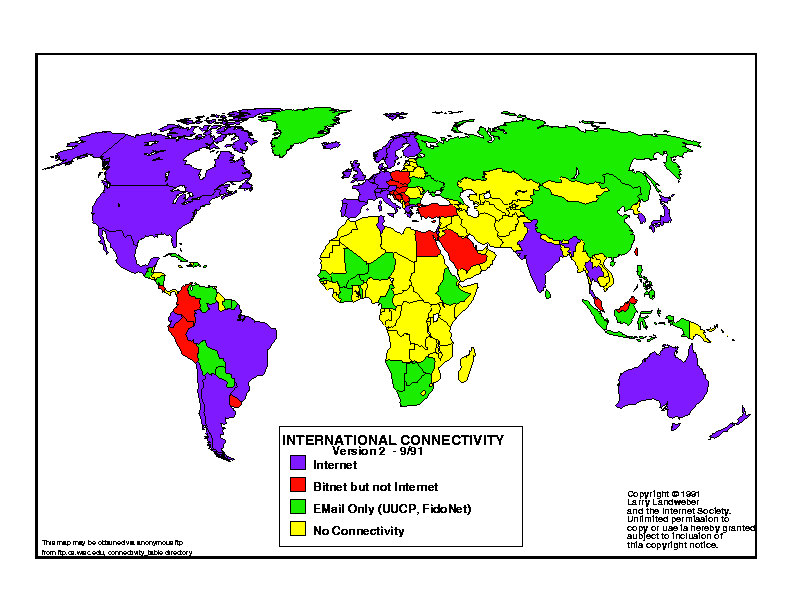
During the 1990s, the Internet has spread rapidly to most countries in the world, as can be seen from Larry Landweber's map of international connections. E-mail and BITNET/EARN, with their less demanding services, reached most countries slightly ahead of the Internet.
This section provides more precise figures for the above animation. We can see that BITNET and especially the OSI networks, which once aspired to form the worldwide network of the future, have fallen out of use. Meanwhile, FIDONET and UUCP have continued to exist alongside the Internet, as low-cost dial-up networks for e-mail and news, although the Internet has expanded to almost all the nations of the globe in recent years.
Worldwide Networks Growth: (I)nternet (B)ITNET (U)UCP (F)IDONET (O)SI
____# Countries____ ____# Countries____
Date I B U F O Date I B U F O
----- --- --- --- --- --- ----- --- --- --- --- ---
09/91 31 47 79 49 02/94 62 51 125 88 31
12/91 33 46 78 53 07/94 75 52 129 89 31
02/92 38 46 92 63 11/94 81 51 133 95 --
04/92 40 47 90 66 25 02/95 86 48 141 98 --
08/92 49 46 89 67 26 06/95 96 47 144 99 --
01/93 50 50 101 72 31 06/96 134 -- 146 108 --
04/93 56 51 107 79 31 07/97 171 -- 147 108 --
08/93 59 51 117 84 31
Figure: Worldwide Networks Growth
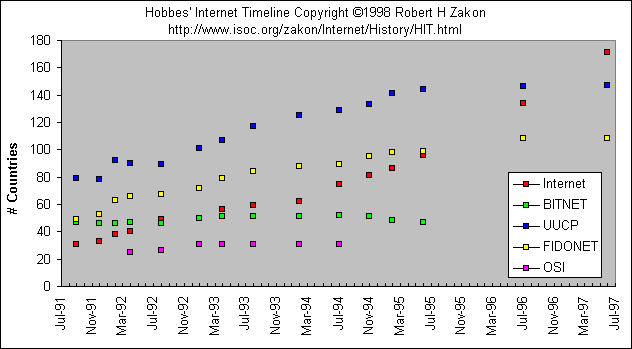
Internet | Networks | WWW | USENET | Security
Internet growth:
Date Hosts | Date Hosts Networks Domains
----- --------- + ----- --------- -------- ---------
1969 4 | 07/89 130,000 650 3,900
04/71 23 | 10/89 159,000 837
06/74 62 | 10/90 313,000 2,063 9,300
03/77 111 | 01/91 376,000 2,338
08/81 213 | 07/91 535,000 3,086 16,000
05/82 235 | 10/91 617,000 3,556 18,000
08/83 562 | 01/92 727,000 4,526
10/84 1,024 | 04/92 890,000 5,291 20,000
10/85 1,961 | 07/92 992,000 6,569 16,300
02/86 2,308 | 10/92 1,136,000 7,505 18,100
11/86 5,089 | 01/93 1,313,000 8,258 21,000
12/87 28,174 | 04/93 1,486,000 9,722 22,000
07/88 33,000 | 07/93 1,776,000 13,767 26,000
10/88 56,000 | 10/93 2,056,000 16,533 28,000
01/89 80,000 | 01/94 2,217,000 20,539 30,000
| 07/94 3,212,000 25,210 46,000
| 10/94 3,864,000 37,022 56,000
| 01/95 4,852,000 39,410 71,000
| 07/95 6,642,000 61,538 120,000
| 01/96 9,472,000 93,671 240,000
| 07/96 12,881,000 134,365 488,000
| 01/97 16,146,000 828,000
| 07/97 19,540,000 1,301,000
| 01/98 29,670,000
| 07/98 36,739,000
Note: A more accurate survey mechanism was developed in 1/98; corrected
numbers are shown in the chart below dating back to 1/95.
For further info, see Sources section below.
Figure: Internet Hosts
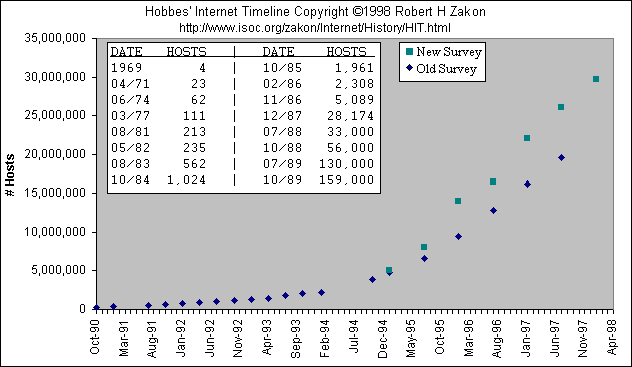
This figure largely reflects the growth in the number of organisations
Figure: Internet Domains
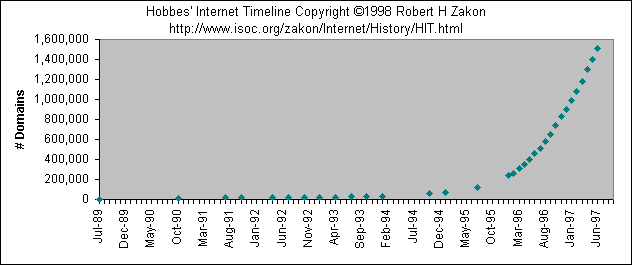
An Internet network address is a kind of postcode for computer networks. This figure largely indicates the growth in the work done by the routers in the backbone network, since they have to know where to send packets for each network. New methods are constantly being developed to reduce the load, so that the Internet will not crash because of its own expansion, as some have predicted.
Figure: Internet Networks
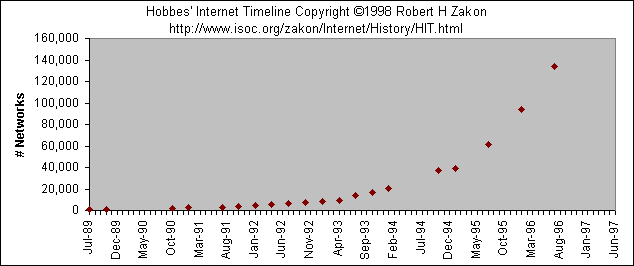
WWW Growth:
Date Sites | Date Sites | Date Sites ----- ---------- + ----- ---------- + ----- ---------- 06/93 130 | 11/96 525,906 | 10/97 1,466,906 12/93 623 | 12/96 603,367 | 11/97 1,553,998 06/94 2,738 | 01/97 646,162 | 12/97 1,681,868 12/94 10,022 | 02/97 739,688 | 01/98 1,834,710 06/95 23,500 | 03/97 883,149 | 02/98 1,920,933 01/96 100,000 | 04/97 1,002,612 | 03/98 2,084,473 06/96 252,000 | 05/97 1,044,163 | 04/98 2,215,195 07/96 299,403 | 06/97 1,117,255 | 08/96 342,081 | 07/97 1,203,096 | 09/96 397,281 | 08/97 1,269,800 | 10/96 462,047 | 09/97 1,364,714 |
Figure: WWW Server Growth
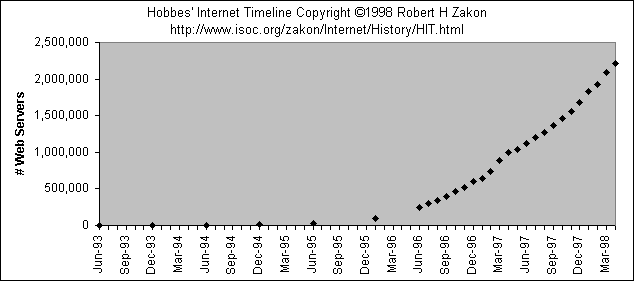
This figure indicates the growth in the Internet 'Letters Page', i.e. public discussion groups. This service, which originated in the UUCP network system, now distributes hundreds of thousands of messages (posts) a day to hundreds of thousands of servers (sites) in various parts of the world. It is possible to keep up with the discussion because users can group their messages hierarchically into 'groups' representing tens of thousands of different topics.
USENET Growth:
Date Sites ~MB ~Posts Groups | Date Sites ~MB ~Posts Groups
---- ----- --- ------ ------ + ---- ------- --- ------ ------
1979 3 2 3 | 1987 5,200 2 957 259
1980 15 10 | 1988 7,800 4 1933 381
1981 150 0.05 20 | 1990 33,000 10 4,500 1,300
1982 400 35 | 1991 40,000 25 10,000 1,851
1983 600 120 | 1992 63,000 42 17,556 4,302
1984 900 225 | 1993 110,000 70 32,325 8,279
1985 1,300 1.0 375 | 1994 180,000 157 72,755 10,696
1986 2,200 2.0 946 241 | 1995 330,000 586 131,614
~ approximate: MB - megabytes per day, Posts - articles per day
Among the millions of Internet users, there are some lost individuals who are unable to act according to the ethical rules of the Net. Fortunately, however, they are few in number compared with the many tens of millions of computers in the Internet. This is presumably a result of the high ethical standards of the majority of users, as well as of the firewalls erected by most organisations to act as gatekeepers. In order to coordinate the resolution of security problems, CERT (Computer Emergency Response Team) centres have been set up, which can be contacted if you suspect computer crime. The CERT network also provides information about any security problems detected, mostly in software, and ways of correcting them. The FUNET's CERT can be found at the addresses http://www.cert.funet.fi and cert@cert.funet.fi
Security (CERT) Incidents:
1988 1989 1990 1991 1992 1993 1994 1995 1996 1997
+ ---- ---- ---- ---- ---- ---- ---- ---- ---- ----
Incidents | 6 132 252 406 773 1334 2340 2412 2573 2134
Advisories | 1 7 12 23 21 19 15 18 27 28
Vulnerabilities | 171 345 311
The following diagram shows the growth in the FUNET's foreign-connection capacity and, for comparison, the total capacity of the sub-Atlantic optic cables. The speed scale is logarithmic in the vertical axis, i.e. each square corresponds to a 10-times increase in speed. From this it is easy to see that the demand for extra FUNET capacity has been about 150% a year for ten years. If development continues like this, then, at the beginning of the 2000s, the FUNET will go over to gigabit-class connections and sub-Atlantic optic-cable capacity will be over a terabit per second. A terabit/s can accommodate about 16 million ordinary 64 Kbit/s phone calls or 200,000 simultaneous MPEG-2-encoded DVD-quality digital TV transmissions at an average speed of 5 Mbit/s. All of this will presumably be integrated into the Internet of the future, when all phone calls are local calls, and almost everyone can set up their own TV station if they want to; even in their hat, as Sci-Fi author David Brin describes the future global network in his book "Earth". The technology needed for hat-TV stations worn by floral-headgeared aunties is already being developed. The communications links would be handled using the future mobile phones, either via earth stations or via a high-density constellation of low-Earth orbit Internet satellites.
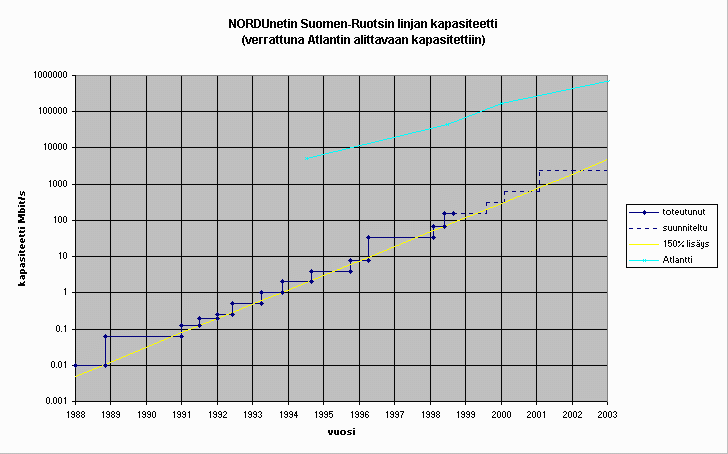
Picture: Markus Sadeniemi CSC/FUNET